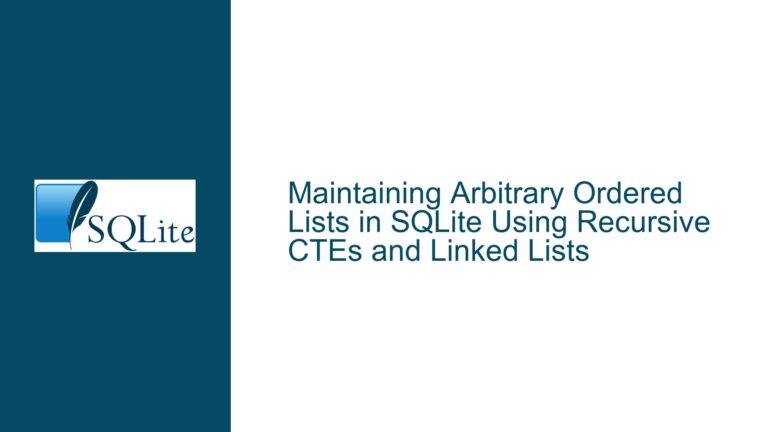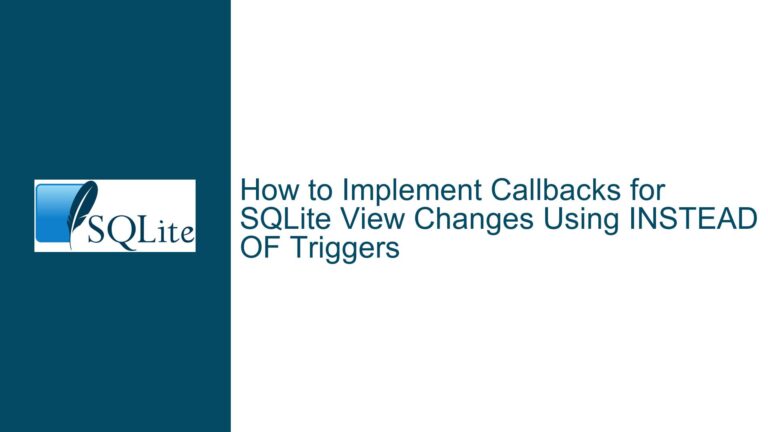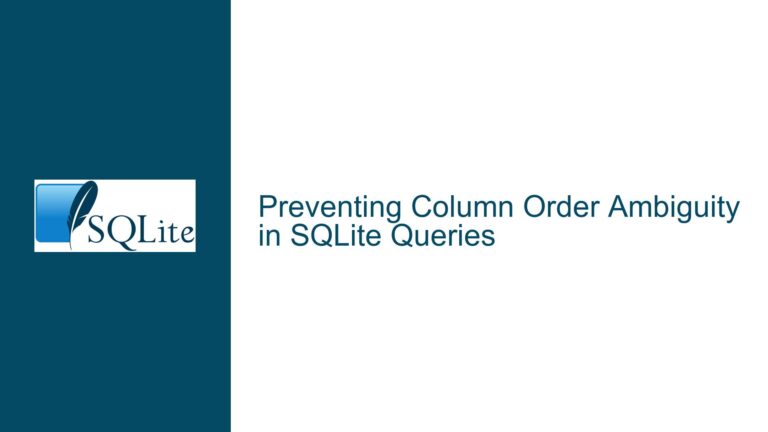Separating SQLite Tables and Indexes into Different Files: Feasibility and Alternatives
SQLite’s Single-File Architecture and the Desire for Separate Table and Index Files
SQLite is renowned for its lightweight, serverless, and self-contained architecture, where the entire database—including tables, indexes, schemas, and metadata—resides in a single file. This design simplifies deployment, backup, and portability, making SQLite a popular choice for embedded systems, mobile applications, and small-scale projects. However, this single-file architecture has led some developers to question whether it is possible to separate tables and indexes into different files, akin to legacy systems like dBase. The primary motivations for such a separation often include performance optimization, distribution efficiency, and organizational preferences.
The idea of separating tables and indexes into distinct files stems from historical database systems where such a division was common. In dBase, for example, tables (.dbf) and indexes (.ndx) were stored separately, allowing for independent updates and distribution. Some developers, particularly those migrating from such systems, seek to replicate this behavior in SQLite. However, SQLite’s architecture and design principles make this approach inherently challenging and, in most cases, unnecessary.
Interrupted Write Operations Leading to Index Corruption
One of the primary concerns raised in discussions about separating tables and indexes is the potential for data inconsistency. In a relational database like SQLite, indexes are tightly coupled with their corresponding tables. An index is essentially a data structure that improves the speed of data retrieval operations by providing a quick lookup mechanism. When a table is modified—through INSERT, UPDATE, or DELETE operations—the corresponding indexes must also be updated to reflect these changes. This synchronization is critical for maintaining data integrity.
If tables and indexes were stored in separate files, ensuring this synchronization would become significantly more complex. For instance, if a power failure or system crash occurred during a write operation, it could result in a scenario where the table is updated but the index is not, or vice versa. This would lead to index corruption, rendering the database inconsistent and potentially unusable. SQLite’s single-file architecture inherently avoids this issue by treating the database as a cohesive unit, ensuring that all changes are atomic and consistent.
Moreover, SQLite’s transaction model relies on the atomicity of write operations. When a transaction is committed, all changes—including updates to both tables and indexes—are written to the database file in a single, atomic operation. This guarantees that the database remains in a consistent state, even in the event of a crash. Separating tables and indexes into different files would undermine this atomicity, making it difficult to ensure consistency without introducing complex and error-prone synchronization mechanisms.
Implementing PRAGMA journal_mode and Database Backup
Given the challenges and risks associated with separating tables and indexes, SQLite provides alternative mechanisms for optimizing performance and ensuring data integrity. One such mechanism is the use of the PRAGMA journal_mode command, which controls how SQLite handles transaction logging. The journal mode determines the level of durability and atomicity provided by the database, and it can be configured to suit specific use cases.
For example, setting the journal mode to WAL (Write-Ahead Logging) can significantly improve performance in scenarios with high concurrency. In WAL mode, changes are written to a separate log file before being applied to the main database file. This allows multiple readers to access the database simultaneously while a single writer commits changes. The WAL mode also enhances crash recovery, as the log file can be used to replay transactions that were in progress at the time of a crash.
Another important consideration is the use of database backups. SQLite’s single-file architecture simplifies the process of creating backups, as the entire database can be copied to a new location with a single file operation. This is particularly useful in distributed systems, where updates to the database need to be propagated to multiple nodes. By leveraging SQLite’s backup API, developers can create efficient and reliable backup strategies that ensure data consistency across the system.
In cases where performance optimization is a priority, developers can also explore the use of WITHOUT ROWID tables. These tables store data in a clustered index format, effectively combining the table and index into a single structure. This can reduce the overhead associated with maintaining separate indexes and improve query performance for certain types of workloads. However, it is important to note that WITHOUT ROWID tables are not a direct replacement for separate index files, as they still reside within the same database file.
Ultimately, while the desire to separate tables and indexes into different files may stem from valid concerns, SQLite’s architecture and feature set provide robust alternatives that address these concerns without compromising data integrity or performance. By leveraging mechanisms such as PRAGMA journal_mode, database backups, and WITHOUT ROWID tables, developers can achieve their goals while adhering to SQLite’s design principles.
Conclusion
The idea of separating SQLite tables and indexes into different files is an intriguing one, particularly for developers with experience in legacy database systems. However, SQLite’s single-file architecture, combined with its emphasis on atomicity and consistency, makes this approach both impractical and unnecessary in most cases. Instead, developers should focus on leveraging SQLite’s built-in features, such as PRAGMA journal_mode, database backups, and WITHOUT ROWID tables, to optimize performance and ensure data integrity. By doing so, they can harness the full power of SQLite while avoiding the pitfalls associated with separating tables and indexes.






